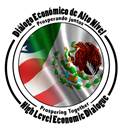 News and Events
News and Events
 HLED Fact Sheet (12/08/16)
HLED Fact Sheet (12/08/16)
 HLED Joint Declaration
HLED Joint Declaration
 Secretary Pritzker's HLED
Secretary Pritzker's HLED
Op-Ed HLED Fact Sheet
HLED Fact Sheet HLED Joint Statement
HLED Joint Statement Initiative Fact Sheets
Initiative Fact Sheets Progress Report on the
Progress Report on the
U.S.-Mexico High Level
Economic Dialogue U.S.-Mexico 21st Century
U.S.-Mexico 21st Century
Border Management Process Updated HLED Fact Sheet
Updated HLED Fact Sheet Secretary Pritzker's HLED
Secretary Pritzker's HLED
Press Release Vice President Biden's HLED
Vice President Biden's HLED
Fact Sheet U.S.-Mexico Energy Business Council
U.S.-Mexico Energy Business Council Federal Register Notice
Federal Register Notice Click here to submit
Click here to submit
feedback to
hled@trade.gov
HIGH LEVEL ECONOMIC DIALOGUE - INITIATIVE FACT SHEETS
 |
Energy: Fact Sheet |
The energy relationship between Mexico and the United States is an important economic driver in both countries. Mexico is currently the United States’ third-largest oil supplier and the United States is Mexico’s number one supplier of gasoline and natural gas. For reasons of geography alone, Mexico is an obvious partner in achieving our sustainability goals. We share a 2,000 mile border, water sources, animal and marine species, people, and energy resources such as the Eagle Ford shale formation in the U.S. and the Cuenca de Burgos in Mexico. We will continue to work with Mexico, as we have for decades, in the preservation of habitat, safe exploitation of resources, and joint research projects. We will increase our collaboration in all aspects of climate change. The United States and Mexico are committed to the safe, efficient and fair development of trans-border energy reserves under the strictest safety and environmental standards.
The United States and Mexico share best practices on the responsible and environmentally conscious development of non-conventional gas resources, as well as in developing renewable energy, energy efficiency, trans-border electricity trade, bilateral renewable energy trade, and low-emission development. The United States Agency for International Development continues to assist Mexico in developing a Low Emissions Development Strategy (LEDS) and to promote the adoption of renewables and energy efficient technology.
Both the United States and Mexico have pledged to reduce dependence on fossil fuels and have championed the increased use of renewable energy. In July, 2014, the U.S.-Mexico Transboundary Hydrocarbons Agreement went into effect. It promotes the joint exploration and development of hydrocarbon reserves that cross our maritime border in the Gulf of Mexico and strengthens North America’s energy security.
At the January 2015 High Level Economic Dialogue (HLED), for the first time, our governments agreed to add energy cooperation to the HLED work-plan. The United States and Mexico will enhance communication and collaboration between our energy agencies, increase regulatory cooperation, facilitate energy-related equipment across our border, share publicly available technical data and information about investment opportunities in the energy sector, and enhance education and capacity-building programs, including training energy regulators, to support Mexico’s energy reform. We will also continue efforts to promote renewable energy and share strategies for low-emission development.
Mexico leads the energy efficiency working group within the Energy and Climate Partnership of the Americas (ECPA), an initiative that leaders of the Western Hemisphere embraced at the 2009 Summit of the Americas. We will continue to support Mexico’s leadership in ECPA as it hosts the upcoming ECPA ministerial in early 2015.
Mexico also will host the Sixth Clean Energy Ministerial (CEM) in 2015. These important international fora advance clean energy deployment and reduce the climate change impacts of energy technologies in the Western Hemisphere and worldwide. Mexico and the United States collaborate through the multilateral initiatives of the CEM to share knowledge and conduct joint research in energy efficiency and power sector integration of renewable energy and smart grid technologies. These initiatives are providing ongoing support for Mexico’s energy reforms through technical assistance funded by the United States and leveraged from non-governmental foundations.
Regarding clean energy and emission reduction, Mexico has cooperated with various U.S. States, including California, with which it subscribed to a bilateral agreement to promote clean energy cross border investments. The document, signed in July 2014 by Governor Jerry Brown and Mexico’s Energy Secretary Pedro Joaquin Coldwell, encourages joint efforts for the development and use of renewable energy, bio-fuels and other clean energy technologies, as well as integrating Baja California to California's energy market.
With the HLED, we prosper together.

The International Trade Administration, U.S. Department of Commerce, manages this global trade site to provide access to ITA information on promoting trade and investment, strengthening the competitiveness of U.S. industry, and ensuring fair trade and compliance with trade laws and agreements. External links to other Internet sites should not be construed as an endorsement of the views or privacy policies contained therein. This site contains PDF documents. A PDF reader is available from Adobe Systems Incorporated.
